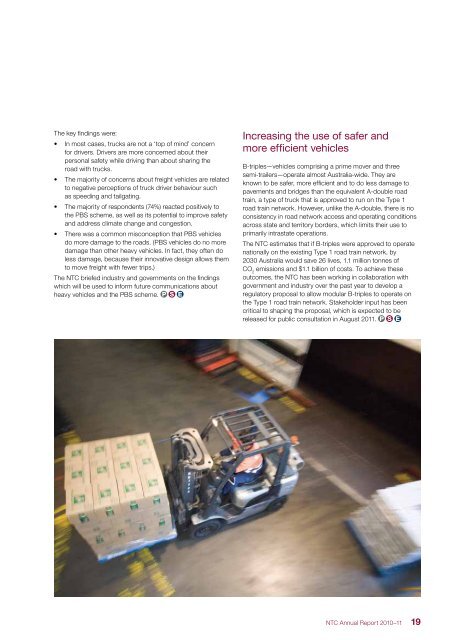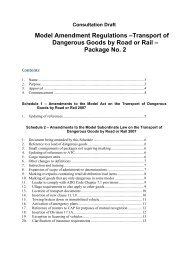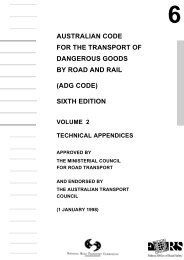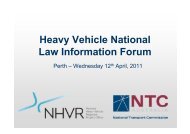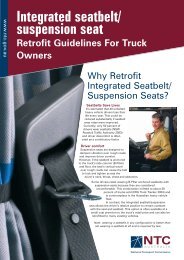2011 Annual Report - National Transport Commission
2011 Annual Report - National Transport Commission
2011 Annual Report - National Transport Commission
You also want an ePaper? Increase the reach of your titles
YUMPU automatically turns print PDFs into web optimized ePapers that Google loves.
The key findings were:<br />
• In most cases, trucks are not a ‘top of mind’ concern<br />
for drivers. Drivers are more concerned about their<br />
personal safety while driving than about sharing the<br />
road with trucks.<br />
• The majority of concerns about freight vehicles are related<br />
to negative perceptions of truck driver behaviour such<br />
as speeding and tailgating.<br />
• The majority of respondents (74%) reacted positively to<br />
the PBS scheme, as well as its potential to improve safety<br />
and address climate change and congestion.<br />
• There was a common misconception that PBS vehicles<br />
do more damage to the roads. (PBS vehicles do no more<br />
damage than other heavy vehicles. In fact, they often do<br />
less damage, because their innovative design allows them<br />
to move freight with fewer trips.)<br />
The NTC briefed industry and governments on the findings<br />
which will be used to inform future communications about<br />
heavy vehicles and the PBS scheme.<br />
Increasing the use of safer and<br />
more efficient vehicles<br />
B-triples—vehicles comprising a prime mover and three<br />
semi-trailers—operate almost Australia-wide. They are<br />
known to be safer, more efficient and to do less damage to<br />
pavements and bridges than the equivalent A-double road<br />
train, a type of truck that is approved to run on the Type 1<br />
road train network. However, unlike the A-double, there is no<br />
consistency in road network access and operating conditions<br />
across state and territory borders, which limits their use to<br />
primarily intrastate operations.<br />
The NTC estimates that if B-triples were approved to operate<br />
nationally on the existing Type 1 road train network, by<br />
2030 Australia would save 26 lives, 1.1 million tonnes of<br />
CO emissions and $1.1 billion of costs. To achieve these<br />
2<br />
outcomes, the NTC has been working in collaboration with<br />
government and industry over the past year to develop a<br />
regulatory proposal to allow modular B-triples to operate on<br />
the Type 1 road train network. Stakeholder input has been<br />
critical to shaping the proposal, which is expected to be<br />
released for public consultation in August <strong>2011</strong>.<br />
NTC <strong>Annual</strong> <strong>Report</strong> 2010–11 19


